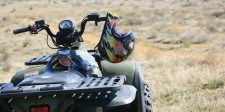Are off-road vehicles safe for children and youth?
Off-road vehicles (ORVs) are motorized ride-on vehicles with 4 wheels and large, low-pressure tires. ORVs include all-terrain vehicles (ATVs) and side-by-sides (SxSs), which are increasingly popular and comprise both utility terrain vehicles and recreational off-highway vehicles. They are designed specifically for off-road use, and are not to be used on paved, public roads, where risks of injury are significantly higher. ORVs are powerful motorized vehicles that can reach high speeds.
Children and adolescents younger than 16 years old should not operate ORVs. Young people don’t have the knowledge, strength, good judgment, and maturity to be able to operate these vehicles safely. Combined with a tendency to be impulsive and take risks, adolescents are at especially high risk of injury when using ORVs, as are young children as passengers.
Nonetheless, many children and teens do use them, primarily for recreational purposes – especially in rural or remote areas. Each year, many children and adolescents are seriously injured or even killed while riding on an ORV.
While the basic design of these vehicles pose serious risks, the most common causes of ORV crashes and resultant injuries are:
- driver error in judgement or ability, often resulting in loss of control
- carrying a passenger on an ATV
- high speed
- inappropriate road use
- lack of appropriate personal protection (ie. helmets etc.)
Did you know?
- In Canada, as many as 35% of ORV-related deaths are among children and youth under 16 years old, even though they represent a small portion of all drivers or passengers.
- Children and adolescents riding as passengers represent 19% of hospitalizations and 28.3% of fatalities related to ORV injuries in Canada, even when riding with adult drivers.
- Fatalities in older adolescents are primarily due to rollovers, while vehicle ejection is more common among younger children because they are often seated as passengers
An injury is more likely to happen when an ORV is not operated according to the manufacturer’s instructions. If you’re a parent who owns or has access to an ORV, model safe behaviours for your children by following these guidelines:
Use only four-wheeled vehicles: Injuries are more likely to occur on three-wheeled ATVs, which are more unstable than four-wheeled vehicles. Three-wheeled ATVs should be avoided.
No passengers on ATVs: Most ATVs are meant to be used by a single driver. Drivers of ATVs designed for single riders should never take on passengers. Passengers are generally not recommended on any ATV because they can affect the vehicle’s balance and make it hard for the driver to stay in control. Children and teens younger than 12 years old should never ride as passengers.
Wear proper equipment: ORV drivers and passengers should always wear a government-certified safety helmet (such as a helmet meeting the Canadian Standards Association, Department of Transportation/Federal Motor Vehicle Safety Standard, Snell or American National Standards Institute motorcycle helmet standards), not a bicycle helmet. Helmets can reduce fatal head injuries by 50%. Eye protection, and proper clothing, such as boots, gloves and long pants are also recommended. In a side-by-side, seatbelt use is essential to prevent ejection in case of a collision or rollover.
Take training: All ORV drivers should take an approved training course. The training should require the driver to pass a test demonstrating both skills and knowledge.
No one should use drugs or alcohol before or while using an ORV.
Are there laws in Canada about operating ORVs?
Laws governing ORV use are different in each province and territory.
- Most provinces require ORV drivers to wear helmets.
- Most provinces have restrictions for young drivers. Some require, for example, that drivers under 14 years be supervised by an adult.
Additional resources
Reviewed by the following CPS committees
- Injury Prevention Committee
Last updated: February 2025

